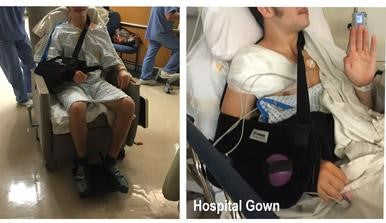Lower Back Pain
Your quest for the perfect golf swing can lead to serious back pain. A rotational golf swing can considerably pressure the back muscles. With four to five hours of a bent-over stance, and repeating the same motion hundreds of times during a game, it is no wonder that playing golf causes strains in your back.Prevention
In order to prevent back pain, practice correct form when you’re off the course. Regular back exercises will strengthen your muscles and help prevent injuries. Focus on trapezius and pectoral muscle flexibilities (these are the muscles in charge of spinal alignment). Yoga can also help to promote proper posture. Regular workouts help avoid injuries down the line!There are various ways to ease golf related back pain. Some will work better than others, depending on the severity of your condition. We recommend the following treatments in order for mild to severe pain:
- Rest
- Alternating hot and cold packs
- Inversion table exercises
- Use of Painkillers
- Massages with oil or heat therapy
- Visit a chiropractor
Tendinitis in the elbow
Tendinitis in the elbows can come from injuries sustained from repeated motions of the same joints or a sudden elbow movement. Tennis players and golfers can both easily get tendinitis of the elbow because of repetitive swings. Tendinitis in the elbow is often referred to as “tennis elbow” or “golf elbow”.
Tennis elbow or golf elbow results from irritated muscles caused by repetitive movements, which leads to inflammation of various tendons around your elbows.
The difference between the two types comes down to where exactly this irritation occurs. Tennis players experience this at the outer tendon whereas golfers feel it more towards their inner tendon. Most golfers suffer from “tennis elbow” instead of “golf elbow.”
Prevention
To prevent tendonitis in the elbow, make sure you are using proper swing techniques during practice. Overuse of the arm and elbow tendon muscles causes tendinitis. Hence, it’s important to rotate your practice regimen to give those muscle groups adequate rest time.
Treatments for tendonitis in the elbow typically include resting the tendon, decreasing inflammation by icing or medicating, and maintaining muscle strength. In most cases, these treatments will resolve the symptoms promptly so you can return to your game.
Rotator Cuff Injury
If you are an avid golfer, then the four stabilizing muscles in your shoulders may be at risk because of all of that swinging and twisting. If your rotator cuff becomes injured, it can take months for a full recovery. Rotator cuff impingements are when four stabilizing muscles throughout your shoulder blades swell and pinch the space between bones that make up each side of your arm socket. The result is unbearable pain to do simple tasks such as lifting a jug or reaching for something on the top shelf.Another type of shoulder injury can happen because of sudden jerks or twists, which cause some muscle fibers within these tendons or muscle tear. Both common types of rotator cuff injuries cause great pain and decreased ability on the game course.
Prevention
To reduce pain from rotator cuff injuries or to avoid them altogether (especially if you are prone to shoulder problems), it’s important to practice correct form when lifting weights and also maintain healthy muscle tone through stretching of the back/shoulder region along with regular exercise routines involving strengthening those same areas.If you have already suffered a rotator cuff injury, try The RICE method of rest, ice-packs for the first 48 hours after an incident or if there are any signs and symptoms of inflammation (hotness/redness), compression with wraps that support your arm by compressing it against itself while resting in a sling position, and elevation. This can be done by placing pillows under both arms when lying down at night.
Knee Pain
As you focus on a proactive, powerful swing at the beginning of a game, it’s important to know that this can put stress and strain on your weak knee. The knee joint can be strained by rotating with too much force or tension in one direction; this puts stress on other parts, like ligaments and tendons, leading to severe injuries. If you suspect any pain or discomfort while swinging your clubs around, see a doctor before continuing!Prevention
Stretch the hamstrings, calves, and thighs before heading to a round of golf to prevent knee pain. Wear quality shoes with good arch support so that your feet are comfortable and not getting sore after walking around all day. Use a brace if you feel weakness or twinges to prevent any injury!If you already suffer from knee pain, it’s important to get a diagnosis and treatment plan in place from your doctor. Ignoring the knee pain can lead to severe damage that could impair your ability to play competitive sports or any other physical activity for months.
Wrist Injuries
Golf is a strenuous sport that puts the wrists at risk for injury. Pain and tenderness on the top of your wrist, experienced during backswing and impact, are common symptoms. The most common golf-related wrist injury is “tendinitis,” or swelling of ligaments in charge of the wrist movement.Prevention
To prevent wrist injuries, have an annual pre-season conditioning program and year-round exercises to strengthen muscles in control over this area. There are some specific forearm and wrist exercises you can add to your daily exercise regimen to help strengthen your wrist muscles.Neck Injury
From the moment of your first golf swing, you are pulled into a relentless cycle that leaves many new players with painful neck spasms. After tirelessly swinging and hitting balls for hours on end, it’s not uncommon to have tense muscles in your neck. Often these neck muscles shorten cause them to freeze your neck in a stiff, painful position.Prevention
Neck injuries are a common problem for all athletes. However, preventing the injury is actually quite simple: warm up your muscles beforehand and take frequent breaks while playing or practicing. If you’re feeling tired in the neck area, then it’s time for some stretching exercises- focus on strengthening your upper back and shoulder with stretches!Foot and Ankle Injuries
Throughout the golf swing, a person’s body acts as an extension of their arm. Power production starts with each foot pushing against the ground. It moves up the legs to be transferred through your core into your arms, where it is finally released from one hand at impact.Your feet act as key components in this process; each one moves differently during a golf swing - for example, front footing must allow more pronation than its counterpart on your follow-through of the golf swing (hence why most people try not to break it off). Injuries can occur when you lose your balance or footing while swinging improperly without following proper mechanics, such as releasing tension before impact and hitting balls off uneven surfaces!
Prevention
Injuries to the feet and ankles are common among golfers. You will sustain one while playing, so be sure to wear properly fitted shoes when out on the course. Be mindful of your swing mechanics because some injuries can occur from the poor form, such as hacking or swinging too hard for distance which puts more force on bones in ankle joints.Hip Injuries
Hip injuries are caused by the large sliding and twisting forces that happen during a golf swing. The swing involves a tremendous amount of pivoting and twisting movements that require impressive control throughout your gluteal muscles and the muscles responsible for adduction and flexion/extension. These forces cause injuries such as groin strains or lower back pain on account of rotational and shear forces put through these joints by swinging motions.Prevention
The hip joint is a complicated yet delicate area that is easily injured without proper care. Hip injuries are often very similar to rotator cuff tears, and thus the injuries sustained are also very similar. The key to preventing these injuries lies in warming up before playing or working out for long periods and adding flexibility exercises like yoga poses and shoulder circles with strength training such as squats.Final Thoughts
You can prevent the most common golf injuries by following these simple yet effective preventive measures- Work on improving your swing mechanics by taking lessons at least once per month if possible
- Take part in specific conditioning programs before playing (especially for long rounds)
- Buy properly fitted equipment that will keep you safe so you don’t have issues down the line!
- You’ll also need an appropriate warm-up routine and stretches after every round/practice session.
In case you get yourself injured, Reboundwear has the perfect solution for you. Our adaptive clothing collection comes with strategically placed zippers and is bound to make you feel better and healthier. Check out our shoulder surgery shirts now!





Leave a comment
All comments are moderated before being published.
This site is protected by hCaptcha and the hCaptcha Privacy Policy and Terms of Service apply.